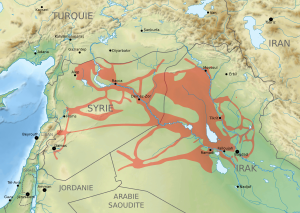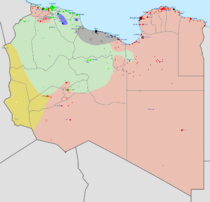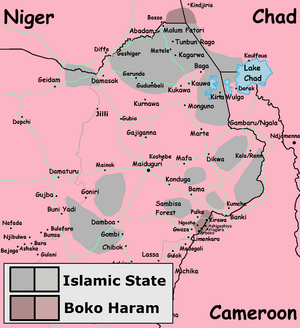Territory of the Islamic State facts for kids
Quick facts for kids
Islamic State
الدولة الإسلامية
ad-Dawlah al-Islāmiyah |
|||||||||||||||||
|---|---|---|---|---|---|---|---|---|---|---|---|---|---|---|---|---|---|
|
Motto: لا إله إلا الله، محمد رسول الله
"Lā ʾilāha ʾillā llāh, Muhammadun rasūlu llāh" "There is no god but God; Muhammad is the messenger of God" دولة الإسلام باقية وتتمدد Dawlat al Islam Baqiyah wa Tatamaddad "The Islamic State remains and expands" خلافة على منهاج النبوة Khilafah ala Minhaj an-Nubuwwah "Caliphate Upon the Prophetic Methodology" |
|||||||||||||||||
|
Anthem:
|
|||||||||||||||||
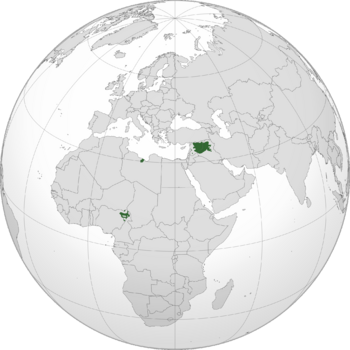
Maximum extent of territorial control, May 2015
|
|||||||||||||||||
| Status | Unrecognized proto-state Designated as a terrorist organization |
||||||||||||||||
| Capital | Raqqa (2013–2017) Mayadin (2017) Hajin (2017–18) |
||||||||||||||||
| Official languages | Arabic | ||||||||||||||||
| Religion | Sunni Islam (Salafism) | ||||||||||||||||
| Government | Unitary Islamic theocratic self-proclaimed caliphate under a totalitarian dictatorship | ||||||||||||||||
|
• Caliph
|
Abu Hafs al-Hashimi al-Qurashi | ||||||||||||||||
|
• Head of the Shura Council
|
Abu Arkan al-Ameri | ||||||||||||||||
| Legislature | Shura | ||||||||||||||||
| Establishment | War on Terror | ||||||||||||||||
|
• Established under the name of Jama'at al-Tawhid wal-Jihad
|
1999 | ||||||||||||||||
|
• Joined al-Qaeda
|
October 2004 | ||||||||||||||||
|
• Declaration of an Islamic State in Iraq
|
13 October 2006 | ||||||||||||||||
|
• Claim of territory in the Levant
|
8 April 2013 | ||||||||||||||||
|
• Separated from al-Qaeda
|
3 February 2014 | ||||||||||||||||
|
• Declaration of caliphate
|
29 June 2014 | ||||||||||||||||
|
• Recapture of Mosul by Iraqi forces
|
10 July 2017 | ||||||||||||||||
|
• Capture of Baghuz Fawqani
|
19 March 2019 | ||||||||||||||||
|
• Operation Kayla Mueller
|
27 October 2019 | ||||||||||||||||
| 3 February 2022 | |||||||||||||||||
| Population | |||||||||||||||||
|
• 2015 estimate
|
(near max extent): 8–12 million | ||||||||||||||||
| Currency | |||||||||||||||||
| Time zone | UTC+2 and +3 (EET and AST) | ||||||||||||||||
|
• Summer (DST)
|
UTC+3 (EEST) | ||||||||||||||||
| Driving side | right | ||||||||||||||||
|
|||||||||||||||||
The Islamic State (IS) is a group that once controlled large areas in Iraq and Syria. This happened mainly between 2013 and 2019. They held control over cities, rural areas, and deserts, especially in the Mesopotamia region.
Today, the group holds smaller, scattered areas of land. They also have groups or cells in other places. These include Afghanistan, West Africa, the Sahara desert, Somalia, Mozambique, and the Democratic Republic of the Congo. As of 2023, IS has gained control over parts of Mali.
In early 2017, IS controlled about 45,377 square kilometers (17,520 square miles) in Iraq and Syria. They controlled another 7,323 square kilometers elsewhere. This means they controlled a total of about 52,700 square kilometers. This was much less than their largest control in late 2014. At that time, they controlled between 100,000 and 110,000 square kilometers.
IS has lost a lot of territory in almost every country since 2014. This happened because many people did not support them. Also, military actions were taken against them. By March 2019, their territory in Syria was reduced to a small area. This area was the Syrian Desert pocket, which was surrounded by Syrian government forces.
Most of the Islamic State's land, people, money, and reputation came from the areas they held in Iraq and Syria. In Afghanistan, IS mainly controls land near the Pakistan border. They have lost 87% of their territory there since 2015. In Lebanon, IS also controlled some border areas during the Syrian war.
In Libya, the group acts like a moving rebel force. They take over places and then leave them again. In Egypt, they control 910 square kilometers of land around Sheikh Zuweid. This is less than 1% of Egypt's total area. In Nigeria, a group linked to IS, called Boko Haram, controlled 6,041 square kilometers in 2014. However, they lost most of this land due to military defeats and internal conflicts. By late 2019, IS forces in Africa had taken large areas in Nigeria again. As of 2021, these forces still run their own governments in the territories they control. In 2022, most of IS's territory was in northeastern Nigeria, northern Mozambique, and eastern Mali.
Contents
- How the Islamic State Forms New Groups
- What the Islamic State Believes
- Where the Islamic State Claims Territory
- Claims in Lebanon and Tunisia
- Claims in Kurdistan
- Claims in Iraq and Syria
- Claims in Afghanistan and Pakistan
- Claims in Libya
- Claims in Egypt
- Claims in Saudi Arabia
- Claims in Yemen
- Claims in Algeria
- Claims in Nigeria and West Africa
- Claims in the North Caucasus
- Claims in Gaza
- Claims in Somalia
- Claims in East Asia
- Claims in the Democratic Republic of the Congo
- Claims in Mozambique
- Claims in India
- Claims in Bangladesh
- Claims in Azerbaijan
- Claims in Turkey
- How the Islamic State is Organized
- See Also
How the Islamic State Forms New Groups
The Islamic State's magazine, Dabiq, explained how they set up new provinces. First, groups in an area must join together. Then, they must publicly promise loyalty to the IS leader, called the caliph. The group needs to choose a Governor (called a Wāli). They also need a religious leadership council (called a Shura Council). Finally, they must plan how to take control of land and follow Sharia law. Once accepted, IS considers the group a new province and gives it support.
IS has mentioned supporting groups in places like East Turkestan, Indonesia, and the Philippines. They claimed they would create provinces in these areas. This would happen after they formed direct connections with their supporters there.
What the Islamic State Believes
An IS spokesperson, Abu Muhammad al-Adnani, said that all other groups and states become invalid when IS expands its power. This means IS does not accept the borders set by Western countries during World War I. They believe they can take over land in Syria and Iraq. The Long War Journal says this means IS would see other groups like Al-Qaeda in the Arabian Peninsula (AQAP) as not legitimate if they do not join IS.
Some IS branches, like those in Libya and Egypt, have been very active. They have tried to control land. Other branches, like those in Algeria and Saudi Arabia, have been less active. They do not seem to have a strong presence.
Since 2022, IS has not officially announced any new provinces. This is true even though groups in Somalia, Bangladesh, and the Philippines have pledged loyalty to IS. Analysts think this is because many of IS's current provinces have not done well. IS leaders now seem to call new groups simply "soldiers of the caliphate."
When IS lost its main territory, it started to carry out more attacks in other countries.
Where the Islamic State Claims Territory
The Islamic State mainly claimed land in Syria and Iraq. They divided each country into many wilayah (provinces). These were often based on existing government borders. The first claims outside Syria and Iraq came on November 13, 2014. Their leader, Abu Bakr al-Baghdadi, announced new provinces in:
- Libya (called Wilayah Barqah, Wilayah Tarabulus, and Wilayah Fazan)
- Algeria (Wilayah al-Jazair)
- Sinai, Egypt (Wilayah Sinai)
- Yemen (Wilayah al-Yaman)
- Saudi Arabia (Wilayah al-Haramayn)
In 2015, new provinces were also announced in:
- The Afghanistan–Pakistan border (Wilayah Khurasan)
- Northern Nigeria (Wilayah Gharb Ifriqiyyah)
- The North Caucasus (Wilayah al-Qawqaz)
- The Sahel region (Sahil)
Claims in Lebanon and Tunisia
On December 9, 2022, IS shared photos of fighters in Lebanon. They said Lebanon was now a province. They also announced the return of the Tunisian province.
Claims in Kurdistan
In November 2014, the Islamic State released a video. In it, two of their fighters said IS would create a province for Kurdistan if they captured it.
Claims in Iraq and Syria
When a group in Iraq, the Mujahideen Shura Council, formed the Islamic State of Iraq in October 2006, they claimed control over seven Iraqi provinces. These included Baghdad, Al Anbar, and Nineveh.
In April 2013, the group changed its name to Islamic State of Iraq and the Levant. They expanded into Syria. They claimed nine Syrian provinces, covering most of the country. These included Raqqa, Homs, and Halab. Later, they divided their controlled territory into new provinces like al-Furat and Fallujah. On December 9, 2017, Iraqi military forces announced they had won the war against IS in Iraq. IS no longer controlled territory there.
Since mid-2018, IS has called its territory in the Levant simply Wilayat al-Sham (Syria Province). They call Iraq Wilayat al-Iraq (Iraq Province). However, they still mention specific regions within these territories.
As of 2022, IS seems to be focusing more on Syria than Iraq. They are now in small pockets in the Syrian desert. Local tribes help the U.S. and other forces by giving information. Despite this, IS managed a large prison break in January 2022.
Claims in Afghanistan and Pakistan
On January 29, 2015, Hafiz Saeed Khan and other fighters in the region promised loyalty to Abu Bakr al-Baghdadi. Khan was then named the Governor (Wāli) of a new branch in Afghanistan and Pakistan. It was called Khurasan Province, named after the historical Khorasan region.
IS tried to settle in Southern Afghanistan, especially in Kandahar and Helmand. But Taliban forces fought against them. They did manage to get a foothold in parts of Nangarhar. They also recruited unhappy members of the Taliban. In August 2015, the leader of the Islamic Movement of Uzbekistan, Usman Ghazi, pledged loyalty to IS. He said his group should be part of Wilayah Khorasan.
The group faced setbacks in 2016. They lost control of some land due to attacks from U.S. Forces, the Afghan Government, and the Taliban.
In 2019, the group announced a new Pakistan province (Wilayah Pakistan). However, as of 2022, the Khorasan province still operates in the country. It also works against neighboring Uzbekistan and Tajikistan. Some members have suggested creating a new province there.
Since the Taliban's takeover of Kabul in 2021, ISIS-K (the Khorasan province) has become a new focus. Their money and numbers have grown. This is because IS fighters were freed from prisons during the Taliban offensive. They have also increased efforts to recruit fighters from Uzbekistan.
Claims in Libya
IS divides Libya into three historical provinces. They claim control over Cyrenaica in the east, Fezzan in the desert south, and Tripolitania in the west, around the capital city.
In 2014, several IS commanders arrived in Derna. This city had been a source of fighters for the Syrian civil war. Over several months, they united local groups and declared war on anyone who opposed them. On October 5, 2014, the fighters, who controlled part of Derna, pledged loyalty to Abu Bakr al-Baghdadi. In February 2015, IS forces took over parts of Sirte. In the following months, they used Sirte as a base to capture nearby towns. IS began to govern Sirte and treated it as their capital.
IS faced defeats from mid-2015. They were driven out of much of Derna after fights with rival groups. Their leader, Abu Nabil al-Anbari, was killed in a U.S. air strike in November 2015. Libya's government launched a major attack against IS around Sirte in May 2016. They captured the city by December 2016.
The group's current leader is Abu Bara al Sahrawi. He took over after Adnan Abu Walid al Sahrawi died in August 2021.
Claims in Egypt
The Egyptian group Ansar Bayt al-Maqdis pledged loyalty to IS in November 2014. After al-Baghdadi's speech on November 13, the group changed its name to Sinai Province. They have carried out attacks in Sinai.
On July 1, 2015, Sinai Province launched a large attack on the Egyptian city of Sheikh Zuweid. More than 300 IS fighters attacked over 15 army and police positions. They used mortars and other weapons to try and capture the city.
In February 2017, the group announced a new "Misr" province in Egypt. This was in a video against Coptic Christians. In 2020, IS in Egypt took over villages in Bir al-Abd town in North Sinai.
As of 2022, the group continues to attack local buildings and systems. However, their power has decreased. This is due to ongoing efforts by the Egyptian government and military. Local tribesmen also help them.
Claims in Saudi Arabia
Al-Baghdadi announced a province in Saudi Arabia in November 2014. He called for the overthrow of the Saudi Royal Family. He also criticized Saudi Arabia for joining the U.S.-led fight against IS. The group has carried out attacks in the country. They used the names Najd Province and Hejaz Province.
Claims in Yemen
IS created a Yemeni province in November 2014. Their first attack happened in March 2015. After the Yemeni Civil War began in 2015, IS struggled to gain a strong presence. This was because of competition from the larger group Al-Qaeda in the Arabian Peninsula (AQAP). Many of IS's local groups in Yemen have not been very active. The group has not been able to take control of land like they did in Iraq and Syria. They have also had problems with leadership and members leaving the group.
As of 2022, the group helps move money between the Somalia and Khorasan provinces.
Claims in Algeria
Members of a group called Jund al-Khilafah pledged loyalty to IS in September 2014. On November 13, 2014, Abu Bakr al-Baghdadi announced the group's name changed to "Wilayah al-Jazair." This was to fit with how other IS-aligned groups were organized. Algerian security forces killed the group's leader in December 2014. They also killed five of its six commanders in May 2015. Since then, the group has not claimed any major attacks and has been mostly quiet.
Claims in Nigeria and West Africa
On March 7, 2015, Boko Haram's leader Abubakar Shekau pledged loyalty to IS. He did this through an audio message online. Abu Mohammad al-Adnani welcomed this pledge. He said it meant IS's caliphate was expanding to West Africa. IS publications from late March 2015 started calling Boko Haram members part of Wilayat Gharb Ifriqiyyah (Islamic State's West Africa Province). Boko Haram faced big losses in the year after this pledge. An attack by the Nigerian military, with help from neighboring countries, drove them from much of their land. Boko Haram split in 2016. IS appointed 'Abu Musab al-Barnawi' as the new leader. This was because of disagreements with Abubakar Shekau. Shekau and his supporters did not accept this and continued to operate on their own.
On January 24, 2022, the small town of Gudumbali was captured and declared the province's capital. However, Nigerian troops recaptured it on January 26.
In the summer of 2022, ISWAP (Islamic State's West Africa Province) gained more territory in Nigeria.
As of September 2022, the group still controls parts of northeastern Nigeria. It has also taken over or joined with its former rival, Boko Haram. Several fighters have rejoined the group. The group also organized a prison break in July near Abuja.
In October 2022, the town of Ansongo was captured by IS's Sahel province.
Claims in the North Caucasus
IS fighters in Syria threatened Russian President Vladimir Putin in 2014. They said, "we will free Chechnya and the entire Caucasus, God willing." In early 2015, leaders of the Caucasus Emirate group in Chechnya and Dagestan announced they were joining IS. They pledged loyalty to Abu Bakr al-Baghdadi. In June 2015, IS spokesman Abu Mohammad al-Adnani accepted these pledges. He appointed Abu Muhammad al-Qadari (Rustam Asildarov) as Governor of a new Caucasus Province. He asked other fighters in the region to join al-Qadari. The group has carried out small, occasional attacks since then.
Claims in Gaza
In February 2014, the Mujahideen Shura Council in the Environs of Jerusalem said they supported IS. On April 2, 2015, parts of this group, along with members of the Army of Islam and a Gaza group called Ansar Bait al-Maqdis, formed the Sheikh Omar Hadid Brigade. This group is also known as Islamic State in Gaza. It mainly operates in the Gaza Strip.
Claims in Somalia
The Islamic State in Somalia (ISS) has been active since 2015. It is a small group of about 300 fighters. Experts think ISS might control some villages in Puntland. The group also managed to capture and hold the town of Qandala for over a month in late 2016. At first, ISS was not officially recognized by the Islamic State. However, this recognition was given by December 2017.
As of 2022, the group helps connect IS provinces in Africa with the leadership in Syria and Iraq. It also helps fund the Khorasan province through Yemen.
Claims in East Asia
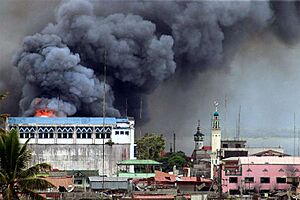
Abu Sayyaf is IS's strongest group in the Philippines. Another IS-linked group is the Maute group. Both groups worked with other IS groups to take parts of Marawi City on May 23, 2017. This started the Battle of Marawi.
On October 16, IS's leader in Southeast Asia, Isnilon Hapilon, and the remaining Maute group leader, Omar Maute, were killed. This was done by the Armed Forces of the Philippines. Two days later, the Philippine military said another senior commander was also likely killed.
The Battle of Marawi was declared over by October 23. All the involved fighters were stopped. This effectively blocked IS's expansion in Asia. The government destroyed the Maute group after the battle.
In December 2017, remaining Maute group members started recruiting new people. They formed a new group called "Turaifie Group." Its leader, Abu Turaifie, claimed to be the successor to Isnilon Hapilon.
As of 2022, only small groups remain in Indonesia and the Philippines. Major attacks have decreased. This is because the governments of both states have been successful in fighting terrorism.
In 2023, IS saw a major increase in activity in the Philippines. This was especially true from August. The group claimed more attacks than in the previous two years combined. This included important attacks like the Mindanao State University bombing in Marawi.
On March 22, 2024, the Philippines announced that Abu Sayyaf had been "fully stopped." This ended the long-running conflict.
According to the Islamic State's Al-Naba newspaper, the group continued attacks until April 11. This has not yet been confirmed by the Philippine Government.
Claims in the Democratic Republic of the Congo
In October 2017, a video appeared on pro-IS channels. It showed a few fighters in the Democratic Republic of the Congo. They said they were part of the "City of Monotheism and Monotheists" (MTM) group. The group's leader said this was the "land of Islam" for the Islamic State in Central Africa. He asked others to join the fight against the government. The Long War Journal noted that this pro-IS group was small. However, it gained a lot of attention from IS supporters. On July 24, 2019, a video was released. It showed IS's presence in the country as the Central African Wilayat. Fighters pledged loyalty to Abu Bakr al-Baghdadi.
As of 2022, the group has doubled its territory and increased its numbers. This is because of organized prison breaks. About 2,000 prisoners have been freed since 2020.
Claims in Mozambique
After taking control of the Mozambican town of Mocímboa da Praia in August 2020, local IS fighters declared it the capital of their province. The fighters then expanded by capturing several islands in the Indian Ocean. Vamizi Island was the most important one.
In May 2022, this province was separated from the Central Africa Province. It became known as the Mozambique Province (ISM).
Claims in India
The Islamic State operates in India and the Kashmir region. They do this through their Islamic State Jammu & Kashmir (ISJK/ISISJK) branch. This branch started in February 2016. The Islamic State – Khorasan Province declared Wilayah [Wilayat] al-Hind (India Province) for IS on May 11, 2019. This happened after clashes in Jammu and Kashmir. In these clashes, ISJK leader Ishfaq Ahmad Sofi was killed.
Shafi Armar, a former member of the Indian Mujahideen, became the chief of operations for IS in India. He and his brother Sultan Armar started the Indian IS groups. These were Ansar-ut Tawhid fi Bilad al-Hind and Janood-ul-Khalifa-e-Hind. However, both brothers were killed in the Syrian Civil War in 2015. This was only confirmed in 2019. Janood-ul-Khalifa-e-Hind has published a pro-IS magazine called Sawt al-Hind since February 2020.
On March 20, 2024, special forces arrested the ISIS India chief, Haris Farooqi. They also arrested one of his helpers. They were trying to cross into India from Bangladesh. Police said the suspects planned many destructive activities and bomb attacks inside India.
Claims in Bangladesh
Islamic State – Bengal Province (Wilayat al-Bengal) is the IS province in Bangladesh. It operates through the group Islamic State Bangladesh (ISB/ISISB). It has claimed attacks in the country since October 2015. Neo-Jamaat-ul-Mujahideen Bangladesh, a group that split from Jamaat-ul-Mujahideen Bangladesh, also operates as its branch.
The first leader of Wilayat al-Bengal, Abu Ibrahim al-Hanif, is thought to be Mohammad Saifullah Ozaki. He was a Bangladeshi Japanese economist who went to Syria in 2015 and joined IS. He was a Hindu who converted to Islam. He reportedly led the 2016 Dhaka attack. He was arrested in Iraq in 2019. Abu Muhammed al-Bengali was then announced as the new leader of the province.
Claims in Azerbaijan
On July 2, 2019, a video was published from Azerbaijan. It showed three fighters pledging loyalty to Abu Bakr al-Baghdadi. This was part of a series of videos showing IS supporters around the world renewing their loyalty. IS officially released the video, calling it the Azerbaijan Wilayat.
Claims in Turkey
Wilayat Turkey was officially announced in July 2019. A video was published by IS showing Turkish fighters pledging loyalty to Abu Bakr al-Baghdadi. The Turkey province was also mentioned before its official announcement. In April 2019, Abu Bakr al-Baghdadi appeared in a video. He was holding files from various provinces IS claimed. One of these was labeled Wilayat Turkey. This was the first known mention of the Turkish province.
How the Islamic State is Organized
The Islamic State's main base was in Ar-Raqqah in Syria. This was until 2017, when it was taken back by the Syrian Democratic Forces. From there, orders were sent to groups called wilayat (provinces). These groups were spread across the Levant, Asia, and Africa. Few of these provinces have named their capital cities. Exceptions include al-Sham with Ar-Raqqah, al-Iraq with Mosul, and Central Africa with Mocímboa da Praia. IS also claimed control over the entire Muslim world. This included Central Asia, parts of the former Ottoman Balkans, South East Asia, and northern Africa. Sometimes, they also wanted to control the whole world.
Ministries of the Islamic State
The Islamic State also set up dāwāwīn (ministries). These were for managing their self-declared state under al-Baghdadi's leadership. They were based on an earlier structure for the Islamic State of Iraq.
| Ministry | When it started | What it does |
|---|---|---|
| Education and Teaching Diwan al-Tarbiyya wa al-Ta’lim |
July 2014 | Manages education, including their own extreme teachings. |
| Services Diwan al-Khidamat |
June 2014 | Manages public areas like parks and roads. For example, they built a highway in Mosul. |
| Rikaz Diwan al-Rikaz |
? | Manages and uses valuable resources. It has two parts: one for oil and gas, and one for old artifacts. |
| Da'wah and Masajid (and Awqaf) Diwan al-Da’wah wa al-Masajid (wa al-Awqaf) |
? | Manages religious outreach and mosques. |
| Health Diwan al-Sihha |
June 2014 | Manages health services and hospitals. They created an "Islamic State Health Service" in 2015. All medical schools were under this ministry. |
| Tribal Relations Diwan al-Asha'ir |
? | Deals with nomadic tribes in the main IS areas. While they treated some tribes badly, other documents show they provided supplies to them. |
| Diwan al-Amn (Islamic State Intelligence) | ? | Manages public safety and operations against spies. |
| Zakah Diwan al-Zakah |
June 2014 | Collects and gives out religious taxes called Zakah. |
| Treasury Diwan Bayt al-mal |
? | Manages the group's money and their currency, the dinar. |
| Hisbah Diwan al-Hisbah |
? | The Hisbah (religious police) worked for this ministry. They made sure the group's version of Islamic law (sharia law) was followed in public. |
| Judgement and Grievances Diwan al-Qada wa al-Mazalim |
? | Manages legal matters, like Islamic court procedures and family issues. |
| Public Relations Diwan al-Alaqat al-Amma |
? | This is their public relations department. |
| Agriculture Diwan al-Zira'a |
June 2014 | Manages farming and livestock. A study showed that harvests in IS territory were fairly normal at first. |
| Fatwa and Investigation Diwan al-Ifta' wa al-Buhuth |
? | Issues and explains religious rulings called fatwas. It also published training materials. |
| Soldiery Diwan al-Jund |
? | Manages the Islamic State's army, including training and deployment. |
| Media Diwan al-I'lam al-Markazi |
? | Manages IS's publications, like AlHayat Media Center, and radio stations. It also handles translations. |
| Fay' and Ghana'im Diwan al-Fay' wa al-Ghana'im |
? | Manages and shares items taken during battles. |
| Real Estate Diwan al-'Aqarat wa al-Kharaj |
? | Manages buildings and land taken from non-Muslims or left empty. These properties were used for fighters or civilians. |
Regional Offices of the Islamic State
The Islamic State created different regional offices between 2017 and 2019. These offices helped organize and direct their people and resources. They also helped restart their operations outside their main areas.
The most active and well-established IS offices that oversee the provinces are:
- Al-Siddiq office in Afghanistan: This office covers South Asia and, according to some UN countries, Central Asia.
- Al-Karrar office in Somalia: This office also covers Mozambique and the Democratic Republic of the Congo (DRC).
- Al-Furqan office in the Lake Chad basin: This office covers Niger, Chad, Cameroon, and Nigeria.
IS has three other regional offices that are not as active or are no longer working well:
- Al-Anfal office in Libya: This office covered parts of northern Africa and the Sahel.
- The Umm al-Qura office in Yemen: This office was responsible for the Arabian Peninsula.
- The Zu al-Nurayn office in the Sinai Peninsula: This office was responsible for Egypt and Sudan.
See Also
- Early Muslim conquests
- Islamic Emirate of Afghanistan
- Divisions of the world in Islam





